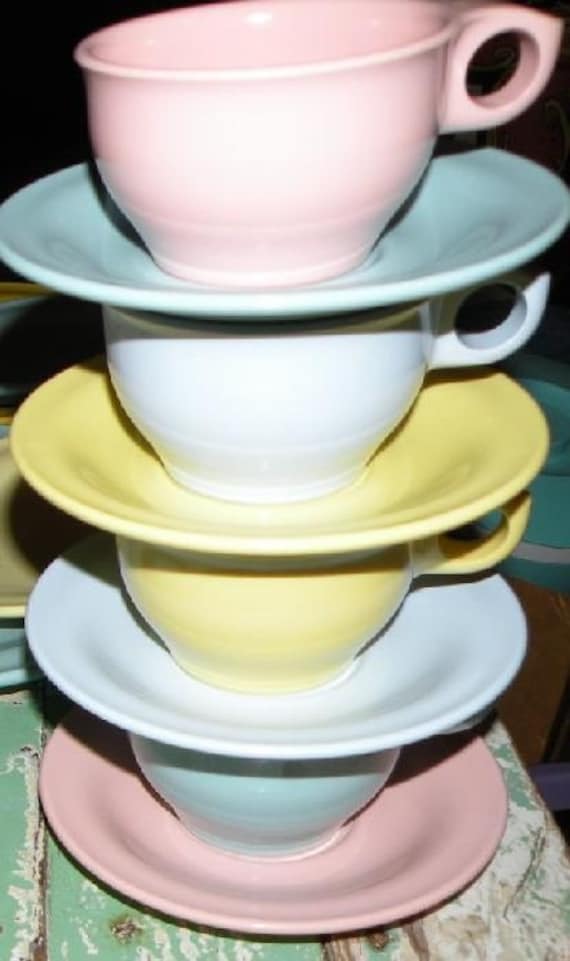WRIGHT DESIGNED A TEST LINE?
During the early forties American Cyanamid approached and commissioned Russel Wright to do testing and provide feedback on the use of melamine (mel-a-meen, also referred to as Melmac) in the household. Then Cyanamid President "William Bell" had a wife that adored Wright's attention to detail. The goal was to case study the existing examples in the early market and suggest ways to enhance it so that it would be widely accepted. *Note: During this time it was very cost effective to utilize the cheap cost of melamine and institute use of plastics! It was at this time Wright studied Don Edwards Co, and Devine in addition to other companies already using melamine dinnerware.
Wright's feedback was that consumer use had to be encouraged, and that consumer trust was down thanks to problems with earlier plastics. Beetleware dishes had been produced in fashion colors, but were more expensive than china and scratched over time. Additionally Bakelite plastics turned brittle. Casein (made from milk and soy) would not withstand water. America had a lot to do to improve plastics in wartime.
When you are finished this page, make sure to read about the disappearing mug shown above, HERE!
Wright drafted (later called Meladur) dinnerware prototypes in March 1944, which included a stack-able coffee mug and grill plate. Samples were molded under the backstamp "Cyanamid Plastics" and tested in several restaurants in New York City and institutions between 1945-1946. It is unclear whether they were molded at the Cyanamid facility or by GATX, who would later pick up the line. A few examples of these do exist and are considered extremely rare.
Verification of the dates are based on proof. Drawings, mockups, and blueprints existed 1945-1946 readily found when I visited Syracuse, and it's safe to say that pieces went into production during this time, or soon thereafter. Further proof of this refers to date 1945 (Patchett: Double Trouble) talking about Wright circa 1945 doing research for American Cyanamid. Another article dated 1946 shows the actual mug in question. A 1947 Modern Plastics Encyclopedia refers to the "field test experiment" by American Cyanamid and the melamine--we can assume this information collected in 1946 for the 1947 edition. A 1948 Plastics & Polymers Issue 16 courtesy of the Plastics Institute explains , "The American Cyanamid Company in New York have been trying out an enterprising experiment. They had some tableware specially designed by Russel- Wright and they have had it put under test in five or six restaurants..."
The test was referred to everywhere and anywhere, for years after to reinforce the quality of melamine. In Retail Clerks Advocate, from 1951 (vol 1954-1955) they explained that American Cyanamid did the tests to interest other molders to mold dishes. They wrote "Test installations were made in restaurants, drug chains, schools and institutions. When these tests proved satisfactory, American Cyanamid made it available to fifteen molding firms...."
One source says that white was produced exclusively to be used by the dozens in a New York City diner specifically to test staining. The only white I've seen has a signature, and very little of it as shown under the "red arrow" below.

Picture shows GATX colors, including some rare white pieces.
Cyanamid had commissioned Wright for the studies but had not promised to mold the actual dinnerware for sale in society. Being a distributor of the melamine molding powders; they no interest in doing so for this would alienate their many molders they sold powders to. Their interest was to encourage melamine dishes in the household, thereby boosting their powder sales. Encouraging molders to jump on board and mold dishes--it is said that after such studies they were able to encourage 13 to 15 new molders in the first year alone to order the melamine and start molding! Bell would try to help Wright find a moulder for his own line after the experiment. In Syracuse files, correspondence was favorable between Bell and Wright.
MORE ABOUT MELMAC AND CYANAMID
American Cyanamid perfected melamine in 1938. They would soon spend their money promoting Melmac powders, and it was being used in the navy, on airlines, and industrially prior to 1946. It made it's way to the table and AM CY would spend lots of money promoting this plastic tableware to the fullest extent much to Wright's advisement. Their ads often featuring and naming multiple customers and hyping up the latest styles, "unbreakability", and durability of this super duper new plastic! There was a huge campaign between 1953-1956.
If you were a plastics molder, you would have to buy Melmac molding powders via Cyanamid or else you could not use the word "Melmac." Other places did offer the melamine compound, but the benefits of paying more thru Cyanamid was "quality" and "advertising."
In addition, there were industry standards to adhere to --in earlier times this meant an inspector may come to ensure your factory was meeting quality standards and thickness guidelines.
According to Mr. Paul Rothstein of Rainboware in Canada, the inspections stopped by the mid 50's as prices soared and manufacturers tried to acquire powders at lower costs.. Truly all Melmac was was melamine---of which if the molder didn't want to pay top price for it's powders, they could perhaps use Plaskon or generic melamine powders and still mold dishes. The backstamp and print ad would simply say "molded of melamine" and would not be endorsed by American Cyanamid.
Meanwhile, Wright's frustration without having an immediate molding contract ensued, and as he watched as all the other melmac companies around him emerging to the consumer's table starting with Watertown Lifetime Ware in 1946 (Watertown having been a major player in early melamine dishes, for the navy, and airlines!) For a great Watertown site, and more on early plastics, visit my good pal Christopher at Plastic Living!
MELADUR IS FINALLY HERE!

Original sketch for backstamp.
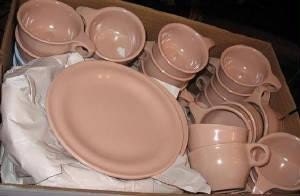
The official production of Meladur did not occur until 1949, (some sources say 1947). This was particularly thanks to Bell who convinced General American Transportation Company's Plastics Division (GATX) to pick up the line. GATX had undergone some changes. In 1945, and had actually consolidated a car building into it's plastic plant. All molding would be done out of Chicago.(b1) They molded not just melamine, but all types of plastics, including trash cans for Sears!
The hype was everywhere. There were ads explaining Wright was designing a line, it was announced everywhere from Time Magazine to School and College Publications (b11). Time declared, "Now in Production, MELADUR DINNER WARE by General Americ on. Especially designed for industrial use by famed designer, Russel Wright. Colorful, durable, easy-handling, heat-resistant , practically unbreakable!" (b12) Sadly William Bell would die in 1950, and ironically Wright's problems with GATX would soon follow.
His Meladur line was early melamine, therefore made thick and heavy yet stylish. Most pieces had "scalloped feet" which was not only pretty but served as a nice stacking mechanism and dish-drying feature. Wright even designed the cup and saucer so that even at a 45 degree angle, the coffee would not spill. In my research I received a letter from a gentleman who stated he remembered the Quality department throwing these plates off several stories high to test their durability.
Wright's hope for Meladur was for institutional use and he actually had an open-end contract with opportunity to design a residential line, which was "not needed" by the molders. Unfortunately, his "residential" line would not come until years later due to contract disputes.
Grill plates are relatively hard to find, and in my opinion, rare.
Under GATX, immediately the rights were sold to the grill plate. In my opinion, grill plates in good shape with Wright's signature are hard to find and considered rare. I have yet to determine if this was a dispute on copyright, or if the plate was bought out, it is unclear.
The "stacking cup" that Wright had supposedly designed as part of the test line had appeared in one early 40's magazine feature soon disappeared. No evidence as to why other than speculation that perhaps a copyright or likeness issue with another existing design posed a problem. Maybe the stacking features themselves were copyrighted, as they resembled military wares. Syracuse holds perhaps the only cup in existence designed by Wright, as I've never seen another. These cups had the handles going flush into the rim (another Wright design trait.) I've seen similar designs in many manufacturers were molded for the army, navy, and copyright records exist similar design by HJ Stotter. The blue cups above are Duperite (Australian) are the closest I've seen. Exhibiting similar qualities would be the stacking US Army melmac mugs, and Vanguard (Canadian) cups.
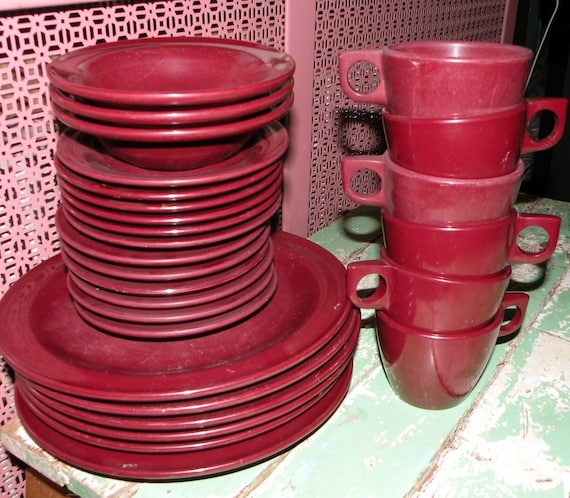
Ironically, GATX replaced Wright's mug with another mug, (above)
probably of their own design.
GATX AND WRIGHT HAVE PROBLEMS
Problems started contractually. Let me first explain in almost every melamine line you will find on this site and Russel Wright there were contract issues. It is my firm belief that none of which was direct fault of Wright, but instead the way in which early contracts were written, and the loyalties of the companies he was dealing with. I have read many opinions that perhaps he was hard to work with, but I truly believe this was not the case. I have seen piles upon piles of correspondence between himself and the factories, and I truly believe that he was cheated out of so many royalties.
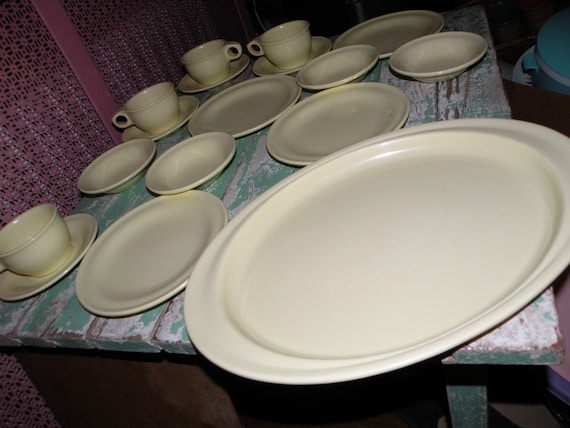
The tray was a completer piece (above) that helped expand use of a set, you will find this marked General American, Lapcor, Rainboware, and more. Unfortunately this was never traced as an official Wright design.
General American felt that they could add accompanying (completer) pieces to, and restyle the feet of Wright's existing designs and drop his signatures and sell the product without paying Wright royalties. They tried to simply state they no longer needed him and end his contract. This however was not the view of Wright or his lawyers. Wright's view of the contract was that any use of likeness of his design would mean royalties. General American thought the contract only meant "use of name" would mean royalties. Mediation and years of battle would ensue. Sadly, Wright was under "Exclusive contract" with this manufacturer.
MELADUR IDENTIFICATION MAYHEM!

During and After contractual disputes, Wright's signatures were dropped. (ie: switched out with a different backstamp) It is safe to say that things were amuck for years. You will find pieces that should contain Wright's signatures but will just say General American. You will see Wright's style bowl without the scalloped feet in a set with a bowl with signatures and scalloped feet. A collector may become very confused very quickly during this time and find complete sets in the same color with three different backstamps.
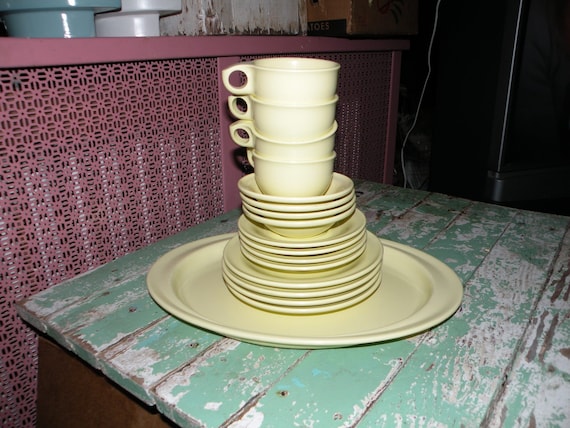
All pieces with signature except tray, which is a non-Wright completer piece.
Here is a list of the Non-Wright completer pieces:
~Coffee Mug (shown above in maroon)
~Open custard style Cup* extremely rare
~Creamer (below)
~Lidded Sugar bowl (below)
~Round Divided Vegetable Bowl (below)
~Round Open Vegetable Bowl *rare
~Serving Platter (shown above in Yellow)
These added pieces to this day have never been proven as a Wright shapes and most likely won't be ever found with signatures. If they are, it may simply be a fluke where the factory left the wrong backstamp in.
Obviously GATX felt by adding accompanying pieces they could sell sets easier, and at this time these dishes were marked to BOTH institutions and households. I have spent years trying to figure out who designed these pieces and no answers. The open cup is rare yet I believe he designed it but I have no proof. It never made sense to me to have someone like Wright with so much attention to detail NOT want a sugar and creamer to accompany his sets, doesn't make sense, does it?
Many collectors will have a set all the same color, with Wright's signature only on half the pieces and General American on the others. This may not impact value, as full sets are more desirable.
THE STANDOFF COSTS TIME
Wright stood adamant (and rightly so) he was still due royalties as long as the actual shapes were being produced; GATX's position was no royalties since the name was not being used. Wright's designs would be produced with flat bases, and in other countries as well. (keep reading)
YEARS of legal battles, an agreement was finally reached but this caused great delay. This cost Wright valuable production time on his residential line. It should be noted I found evidence in Syracuse that Wright had initially wanted to design both a residential and a commerical line. I believe Meladur would have been the commercial line, and ideas for Residential were in Wright's head prior to the production at Northern. Unfortunately while tied up in "exclusive production" with GATX, he could not produce or design elsewhere.
During it's heydey the East Chicago Facilities of GATX employed 1000 workers. (b3) All the while GATX were producing dishes, and not using his name in ads. They were selling to hospital supply distributors who would sell directly to hospitals circa 1952 (b5), institutions, and even were on use on the railroads by 1953! (b4)
After examining stacks of contracts and disputes, it is unclear to me just what happened, although Ann Kerr had previously explained in her research that Wright took a settlement and ran, I read the contracts differently. It appeared to me there were two contracts, one for residential and one for commercial, and that perhaps the real settlement information via mediation or arbitration will never be understood. I often wondered why he would have taken a settlement, when Meladur would live on longer than he would. Perhaps if only to move on and continue designing.
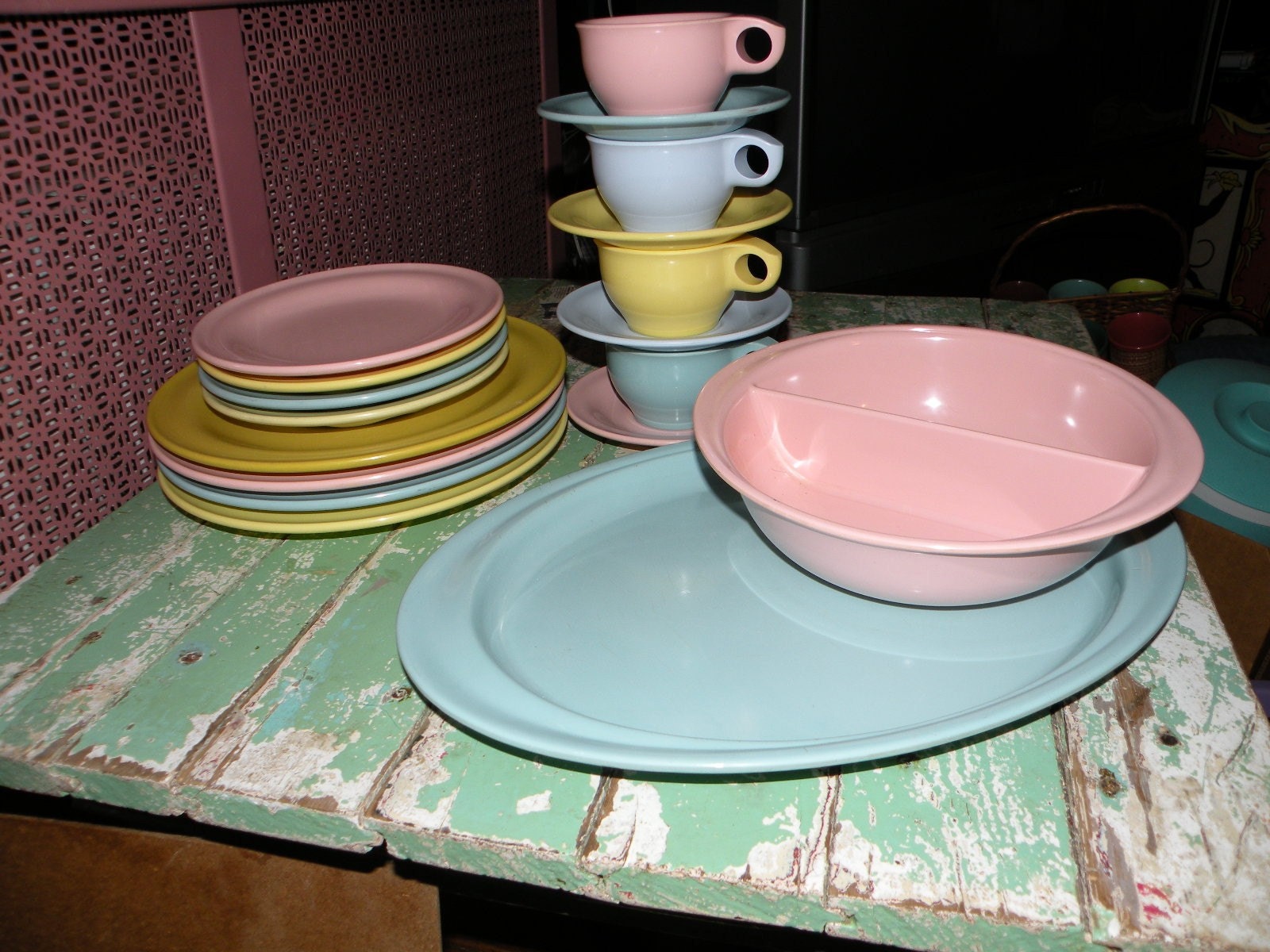
Production of the Lapcor version of Meladur bore the "Meladur by Lapcor" backstamp--pretty pastels and brighter colors emerged. Consumer Reports indicated this happened sometime You will find the original colors that were still produced since the early Cyanamid days, but then new hues shades off!
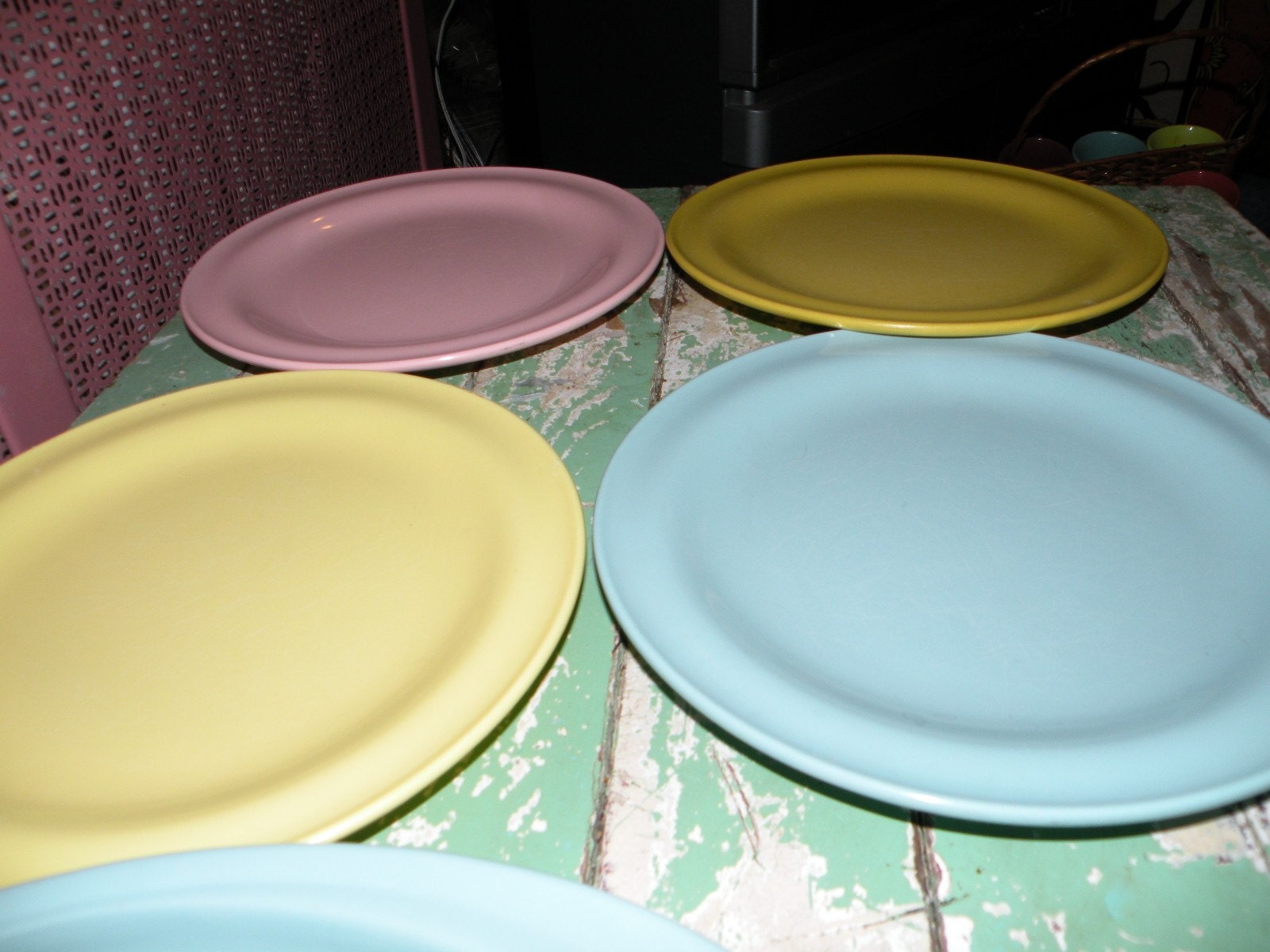
Lapcor produced more than just Meladur dinnerware, including knobs for frying "Mirro" frying pans, plastic channels, in addition to producing melmac for Steston and Sun Valley. Jan remembers the owner being more than wonderful to his employees, she felt like she was part of a "a small family"and only left because she was getting married.
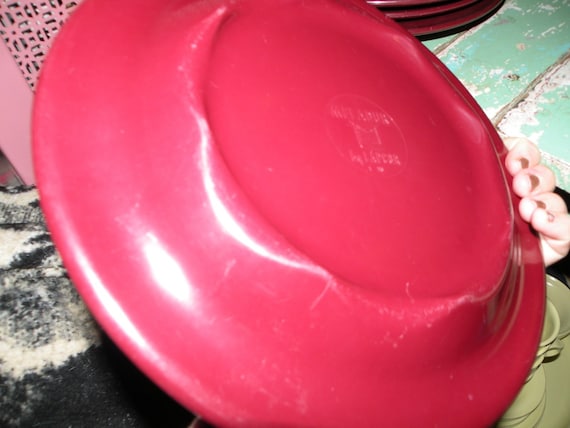
Maroon, originally produced in the GATX still be produced by Lapcor shows the scalloped bases I talked about earlier.
Jan remembers often having letters arrive from customers in regards to replacements. There was often a "guarantee" with most melmac on the market. Janice's letters most often received were about about staining of coffee mug. She fondly remembers having to go to the storage closets and pull a melmac replacement for posting to the customer. Staining was an issue. Just imagine, opening a door to a stockroom loaded with shelves upon shelves of melmac!
I am uncertain just when Meladur production ceased at Lapcor, and if the last dish would have been molded at the Franklin Street or the Division Street address ...do you know? I can't tell you how many letters I've received from the citizens of Manitowoc, about Lapcor plastics, and how it employed someone they knew or loved. Good town citizens like the late Mary Jane Wachal, who dedicated 19 years of her life to Lapcor Plastics, or the late Dorothy J. Gordon, who had 30 years in! Thank you for all the information! It's getting harder and harder to find out information due to the fact the employees I'm looking for worked there in the 50s, which (even if they were in their 20s or 30's) puts them at 80 years old now..
I found evidence that Meladur was still being produced up until 1969 , but it had been announced that the prices would soar due to costly melamine increases. (b8)
MELADUR IN CANADA, WTH?
The speckled Sugar is marked "Sears Regal Warner" which makes me wonder was this a line for Sears? "Rainboware" reproduced the creamer, and sugar bowl in the exact same dimensions sold with the GATX and LAPCOR sets. Coffee cups looked identical to Wright's, dishes, plates and saucers only a few dimensions off...
How the molds got to Canada surely puzzles me. You will find the designs with solid or speckled finishes. Often backstamped Regal, Crown Royal or Rainboware, they were made by Rainbow Plastics, LTD, which was owned by Maplex. At first I thought perhaps Lapcor or GATX sold the molds to Canada- but based on time produced this cannot be. I dug around further and tracked down the owner of the company who produced it in the mid 50s to early 60's.
Previous owner Paul Rothstein (his Father owned it for years) explained to me that at one time, there were only three melmac manufacturers of Canada--his company having been Maplex eventually bought out and owned Rainbow Plastics. So, essentially, he owned two of three factories. Overall, these factories produced all kinds of plastic, and melmac was only a small portion. When asked about the likeness of the molds, he explained that molds would come from tool and die makers and that you could not simply use American designs without permission or at that time you would get fined for copyright infringement.
So it seems that by changing the bases of the dishes, or the dimensions slightly, tool and die makers could make a mold that looked just like Wright's designs of Meladur. Ironically, they didn't bother changing dimensions on the GATX completer pieces like creamers, sugars, or platter because these pieces weren't designed by Wright anyhow. This small detail makes you wonder if the tool and die makers knew exactly how to get around the system.
Makes me sick to think poor old Russel Wright's designs were being sold in Canada--bad enough he didn't get his American royalties. I suppose it wouldn't have affected him all that much, as I've been told by Rothstein, not much melmac was sold. Canadians preferred china to Melmac and even with in-store demonstrations it was a hard sell. He stated, "Texasware sold more melmac in one seasonal Sears Catalog than my company sold in a year."
With so little melmac floating around, who would have noticed that it was (almost to a t) to Wright's Meladur? I should also interject that in Syracuse I found evidence that Wright did have a Canadian sales contact, but I never found proof of royalties--so who really knows. There was also a Cyanamid of Canada, and if we know for a fact Cyanamid of America had used these molds in Wright's test set, could they have sent a bunch to Canada? There are so many possiblities!
Collectors should note that with so little melmac floating around Canadian melamine holds it's value. I paid almost $100 for an off color Rainboware set just because of the limited amount of production pieces and assembling a full set may be somewhat rare. More about this on the value page.
AUSTRALIAN MELADUR?
Aussie examples found also which are Per above, I'm perplexed. Bases are flat, but most dimensions are very similar. This was made by the melamine/plastics manufacturer "Duperite" and is their "Superware" line.
Aussie cups are stacking, and resemble the mugs that Wright originally designed.
Very hard to tell which is which, American or Aussie?
ALLIED CHEMICAL & MELADUR 60's
Other Fake Meladur was produced by Fabricated Products Division of Allied Chemical sometime in the late 60's, cloning only the name, but certainly not the quality. This line bears absolutely NO resemblance to the original Meladur and probably was just a ripoff of the name. After all, trademarks don't last forever.
PROLON & MELADUR CIRCA 1970-1980's?
An Ebay find, these bug the heck out of me. Tiny veggie bowls that are almost identical to the Meladur mold except for the feet. I did some investigating and talked to Mr. Gluck who now owns Prolon. Indeed 9610 was the model number, currently, they offer a 9510 fruit bowl and 9710 fruit bowl line but he does not have the 9610. (WHY, where are the molds now?) There are more references on the web about 9610 being food trays, and other references to 9610 being the color code for white or bone. This is driving me nuts!
DALLAS WARE & MELADUR ?
I found a Dallas Ware cup that looks identical to Meladur, but was short lived, I wonder if they (PMC that produced TexasWare) somehow obtained the molds along the way?
NON-WRIGHT TRAY MOLDS FOUND 2010?

Pink is classic Meladur, white is something new I found on the web and of course soon after lost the link. So I have to do some more investigating, you can be sure I'll be hot on the trail to see if it's Meladur!
OTHER CRAZY STUFF
WTH? A bag of Meladur? It's on this site, in another language! Maybe I should buy some and mold me some dishes!
This is called "Meladur" but obviously is NOT and featured here courtesy of this Museum which I can't read because it's in another language.
Before you go, check out this picture:
During the early forties American Cyanamid approached and commissioned Russel Wright to do testing and provide feedback on the use of melamine (mel-a-meen, also referred to as Melmac) in the household. Then Cyanamid President "William Bell" had a wife that adored Wright's attention to detail. The goal was to case study the existing examples in the early market and suggest ways to enhance it so that it would be widely accepted. *Note: During this time it was very cost effective to utilize the cheap cost of melamine and institute use of plastics! It was at this time Wright studied Don Edwards Co, and Devine in addition to other companies already using melamine dinnerware.
Wright's feedback was that consumer use had to be encouraged, and that consumer trust was down thanks to problems with earlier plastics. Beetleware dishes had been produced in fashion colors, but were more expensive than china and scratched over time. Additionally Bakelite plastics turned brittle. Casein (made from milk and soy) would not withstand water. America had a lot to do to improve plastics in wartime.
 |
| Rare Mug designed by Russel Wright, for test line, out of existence now. |
When you are finished this page, make sure to read about the disappearing mug shown above, HERE!
Verification of the dates are based on proof. Drawings, mockups, and blueprints existed 1945-1946 readily found when I visited Syracuse, and it's safe to say that pieces went into production during this time, or soon thereafter. Further proof of this refers to date 1945 (Patchett: Double Trouble) talking about Wright circa 1945 doing research for American Cyanamid. Another article dated 1946 shows the actual mug in question. A 1947 Modern Plastics Encyclopedia refers to the "field test experiment" by American Cyanamid and the melamine--we can assume this information collected in 1946 for the 1947 edition. A 1948 Plastics & Polymers Issue 16 courtesy of the Plastics Institute explains , "The American Cyanamid Company in New York have been trying out an enterprising experiment. They had some tableware specially designed by Russel- Wright and they have had it put under test in five or six restaurants..."
The test was referred to everywhere and anywhere, for years after to reinforce the quality of melamine. In Retail Clerks Advocate, from 1951 (vol 1954-1955) they explained that American Cyanamid did the tests to interest other molders to mold dishes. They wrote "Test installations were made in restaurants, drug chains, schools and institutions. When these tests proved satisfactory, American Cyanamid made it available to fifteen molding firms...."
FUN FACT: By the mid 1950's it's safe to say there could have been well over 100 or more molders using melmac, melamine, or urea compounds. A huge stretch from the 15 or so from the mid 1940's. An issue of Modern Plastics Encyclopedia will show you a list of custom molders and machinery they used.
One source says that white was produced exclusively to be used by the dozens in a New York City diner specifically to test staining. The only white I've seen has a signature, and very little of it as shown under the "red arrow" below.

Picture shows GATX colors, including some rare white pieces.
Cyanamid had commissioned Wright for the studies but had not promised to mold the actual dinnerware for sale in society. Being a distributor of the melamine molding powders; they no interest in doing so for this would alienate their many molders they sold powders to. Their interest was to encourage melamine dishes in the household, thereby boosting their powder sales. Encouraging molders to jump on board and mold dishes--it is said that after such studies they were able to encourage 13 to 15 new molders in the first year alone to order the melamine and start molding! Bell would try to help Wright find a moulder for his own line after the experiment. In Syracuse files, correspondence was favorable between Bell and Wright.
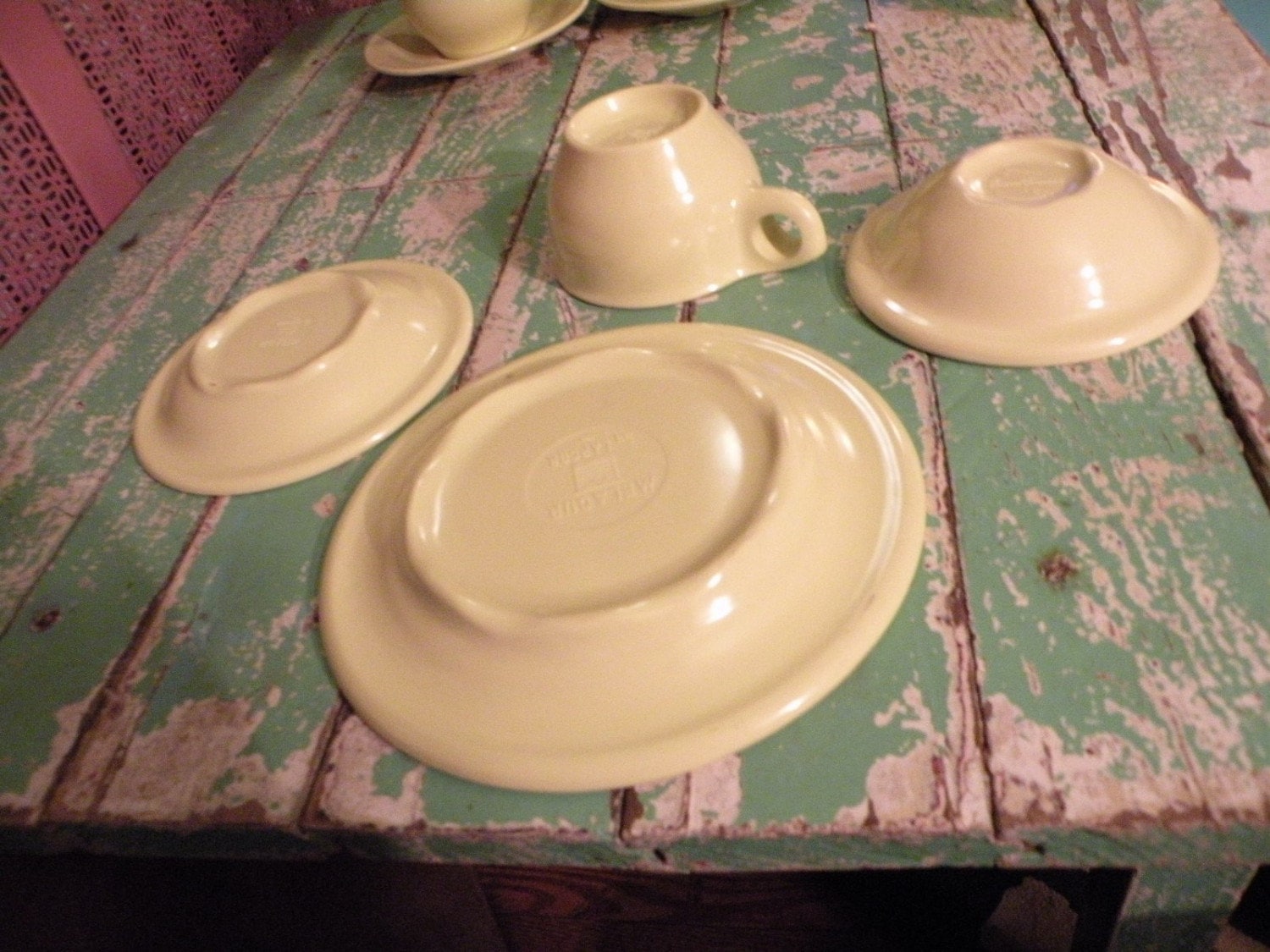 |
| Scalloped bottoms on certain pieces. |
MORE ABOUT MELMAC AND CYANAMID
American Cyanamid perfected melamine in 1938. They would soon spend their money promoting Melmac powders, and it was being used in the navy, on airlines, and industrially prior to 1946. It made it's way to the table and AM CY would spend lots of money promoting this plastic tableware to the fullest extent much to Wright's advisement. Their ads often featuring and naming multiple customers and hyping up the latest styles, "unbreakability", and durability of this super duper new plastic! There was a huge campaign between 1953-1956.
 |
| 1956 Cyanamid Ad |
In addition, there were industry standards to adhere to --in earlier times this meant an inspector may come to ensure your factory was meeting quality standards and thickness guidelines.
According to Mr. Paul Rothstein of Rainboware in Canada, the inspections stopped by the mid 50's as prices soared and manufacturers tried to acquire powders at lower costs.. Truly all Melmac was was melamine---of which if the molder didn't want to pay top price for it's powders, they could perhaps use Plaskon or generic melamine powders and still mold dishes. The backstamp and print ad would simply say "molded of melamine" and would not be endorsed by American Cyanamid.
Meanwhile, Wright's frustration without having an immediate molding contract ensued, and as he watched as all the other melmac companies around him emerging to the consumer's table starting with Watertown Lifetime Ware in 1946 (Watertown having been a major player in early melamine dishes, for the navy, and airlines!) For a great Watertown site, and more on early plastics, visit my good pal Christopher at Plastic Living!
MELADUR IS FINALLY HERE!

Original sketch for backstamp.

The official production of Meladur did not occur until 1949, (some sources say 1947). This was particularly thanks to Bell who convinced General American Transportation Company's Plastics Division (GATX) to pick up the line. GATX had undergone some changes. In 1945, and had actually consolidated a car building into it's plastic plant. All molding would be done out of Chicago.(b1) They molded not just melamine, but all types of plastics, including trash cans for Sears!
The hype was everywhere. There were ads explaining Wright was designing a line, it was announced everywhere from Time Magazine to School and College Publications (b11). Time declared, "Now in Production, MELADUR DINNER WARE by General Americ on. Especially designed for industrial use by famed designer, Russel Wright. Colorful, durable, easy-handling, heat-resistant , practically unbreakable!" (b12) Sadly William Bell would die in 1950, and ironically Wright's problems with GATX would soon follow.
His Meladur line was early melamine, therefore made thick and heavy yet stylish. Most pieces had "scalloped feet" which was not only pretty but served as a nice stacking mechanism and dish-drying feature. Wright even designed the cup and saucer so that even at a 45 degree angle, the coffee would not spill. In my research I received a letter from a gentleman who stated he remembered the Quality department throwing these plates off several stories high to test their durability.
Wright's hope for Meladur was for institutional use and he actually had an open-end contract with opportunity to design a residential line, which was "not needed" by the molders. Unfortunately, his "residential" line would not come until years later due to contract disputes.
Grill plates are relatively hard to find, and in my opinion, rare.
Under GATX, immediately the rights were sold to the grill plate. In my opinion, grill plates in good shape with Wright's signature are hard to find and considered rare. I have yet to determine if this was a dispute on copyright, or if the plate was bought out, it is unclear.
 |
|
These cups are Austrailian (not called Meladur) but are almost identical to Wright's original test cups. (The only one I know of exists in Syracuse!) |

Ironically, GATX replaced Wright's mug with another mug, (above)
probably of their own design.
GATX AND WRIGHT HAVE PROBLEMS
Problems started contractually. Let me first explain in almost every melamine line you will find on this site and Russel Wright there were contract issues. It is my firm belief that none of which was direct fault of Wright, but instead the way in which early contracts were written, and the loyalties of the companies he was dealing with. I have read many opinions that perhaps he was hard to work with, but I truly believe this was not the case. I have seen piles upon piles of correspondence between himself and the factories, and I truly believe that he was cheated out of so many royalties.

The tray was a completer piece (above) that helped expand use of a set, you will find this marked General American, Lapcor, Rainboware, and more. Unfortunately this was never traced as an official Wright design.
General American felt that they could add accompanying (completer) pieces to, and restyle the feet of Wright's existing designs and drop his signatures and sell the product without paying Wright royalties. They tried to simply state they no longer needed him and end his contract. This however was not the view of Wright or his lawyers. Wright's view of the contract was that any use of likeness of his design would mean royalties. General American thought the contract only meant "use of name" would mean royalties. Mediation and years of battle would ensue. Sadly, Wright was under "Exclusive contract" with this manufacturer.
MELADUR IDENTIFICATION MAYHEM!

During and After contractual disputes, Wright's signatures were dropped. (ie: switched out with a different backstamp) It is safe to say that things were amuck for years. You will find pieces that should contain Wright's signatures but will just say General American. You will see Wright's style bowl without the scalloped feet in a set with a bowl with signatures and scalloped feet. A collector may become very confused very quickly during this time and find complete sets in the same color with three different backstamps.

All pieces with signature except tray, which is a non-Wright completer piece.
Here is a list of the Non-Wright completer pieces:
~Coffee Mug (shown above in maroon)
~Open custard style Cup* extremely rare
~Creamer (below)
~Lidded Sugar bowl (below)
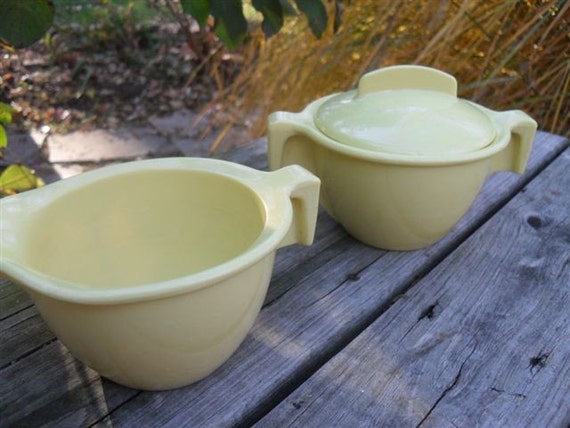 |
| Shoptastic on Etsy offers this Creamer and Sugar. |
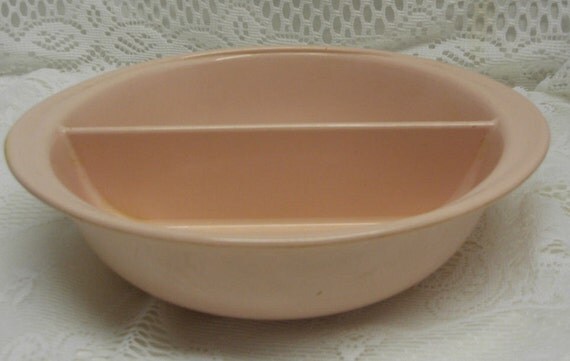 |
| Divided bowl, (in tan) as offered on Etsy by InfinityCrafts. |
~Serving Platter (shown above in Yellow)
These added pieces to this day have never been proven as a Wright shapes and most likely won't be ever found with signatures. If they are, it may simply be a fluke where the factory left the wrong backstamp in.
Obviously GATX felt by adding accompanying pieces they could sell sets easier, and at this time these dishes were marked to BOTH institutions and households. I have spent years trying to figure out who designed these pieces and no answers. The open cup is rare yet I believe he designed it but I have no proof. It never made sense to me to have someone like Wright with so much attention to detail NOT want a sugar and creamer to accompany his sets, doesn't make sense, does it?
Many collectors will have a set all the same color, with Wright's signature only on half the pieces and General American on the others. This may not impact value, as full sets are more desirable.
THE STANDOFF COSTS TIME
Wright stood adamant (and rightly so) he was still due royalties as long as the actual shapes were being produced; GATX's position was no royalties since the name was not being used. Wright's designs would be produced with flat bases, and in other countries as well. (keep reading)
YEARS of legal battles, an agreement was finally reached but this caused great delay. This cost Wright valuable production time on his residential line. It should be noted I found evidence in Syracuse that Wright had initially wanted to design both a residential and a commerical line. I believe Meladur would have been the commercial line, and ideas for Residential were in Wright's head prior to the production at Northern. Unfortunately while tied up in "exclusive production" with GATX, he could not produce or design elsewhere.
During it's heydey the East Chicago Facilities of GATX employed 1000 workers. (b3) All the while GATX were producing dishes, and not using his name in ads. They were selling to hospital supply distributors who would sell directly to hospitals circa 1952 (b5), institutions, and even were on use on the railroads by 1953! (b4)
After examining stacks of contracts and disputes, it is unclear to me just what happened, although Ann Kerr had previously explained in her research that Wright took a settlement and ran, I read the contracts differently. It appeared to me there were two contracts, one for residential and one for commercial, and that perhaps the real settlement information via mediation or arbitration will never be understood. I often wondered why he would have taken a settlement, when Meladur would live on longer than he would. Perhaps if only to move on and continue designing.
 |
| Original factory built in 1945, updates done in the 60's. Photo courtesy listing agent and LoopNet, asking $295,000 for this commercial propery as of 12/29/2010. |
A small factory at 2214 Franklin Street in Manitowoc, Wisconsin was the home of Lakeside Plastic Corp. In 1952, Modern Plastics (vol. 29) shared the announcement that Lakeside Plastics Corp., 2214 Franklin St., Manitowoc, Wisconsin., had changed its corporate name to Lap- cor Plastics, ...enter LAPCOR!
(The 1966 Hardware Age magazine has them listed here as well, but later( 1980's) I see a 2702 Division Street address.)
I've spoken to an interviewed many of the original factory workers and thanks especially to Jan Burkart (Ruh) who was most helpful in the company history and used to be the Office Manager there and remembers the offices (front) being connected to factory (back.) Perhaps the photo above isn't too far off the original look and feel of the factory as it was in 1955. Wisconsin residents were more than forthcoming with information after local historian Marge Miley put me in the paper some time ago.
According to Janice Burkart (Ruh), "The Franklin Street address is the original building where both industrial parts and dinnerware were both made. As the dinnerware division grew, the Division Street building became the main office and dinnerware production plant and the Franklin Street address was just industrial." Jan worked there up until she got married. She continues, " I remember that when I was dating my husband and worked on Franklin Street, we made channels for Kurz and Root and the resin, etc made me smell like plastic – my hair and clothes. Ugh! But he still married me."
It is safe to estimate that in December 1954, Lapcor acquired the Meladur molds and contracts..(b2) I know this because Consumer Reports of November 1954 was testing them under GATX, then released in early 1955 that Lapcor would now be producing the samples that were acquired by testing (which by the way obtained a good rating for durability.) Meladur was continued to be advertised available to hospitals (b5) circa 1956, via the same distributors, which prove Lapcor inherited the customer base. (The 1966 Hardware Age magazine has them listed here as well, but later( 1980's) I see a 2702 Division Street address.)
I've spoken to an interviewed many of the original factory workers and thanks especially to Jan Burkart (Ruh) who was most helpful in the company history and used to be the Office Manager there and remembers the offices (front) being connected to factory (back.) Perhaps the photo above isn't too far off the original look and feel of the factory as it was in 1955. Wisconsin residents were more than forthcoming with information after local historian Marge Miley put me in the paper some time ago.
According to Janice Burkart (Ruh), "The Franklin Street address is the original building where both industrial parts and dinnerware were both made. As the dinnerware division grew, the Division Street building became the main office and dinnerware production plant and the Franklin Street address was just industrial." Jan worked there up until she got married. She continues, " I remember that when I was dating my husband and worked on Franklin Street, we made channels for Kurz and Root and the resin, etc made me smell like plastic – my hair and clothes. Ugh! But he still married me."

Production of the Lapcor version of Meladur bore the "Meladur by Lapcor" backstamp--pretty pastels and brighter colors emerged. Consumer Reports indicated this happened sometime You will find the original colors that were still produced since the early Cyanamid days, but then new hues shades off!

Original yellow front left, new mustard in rear.
Lapcor produced more than just Meladur dinnerware, including knobs for frying "Mirro" frying pans, plastic channels, in addition to producing melmac for Steston and Sun Valley. Jan remembers the owner being more than wonderful to his employees, she felt like she was part of a "a small family"and only left because she was getting married.

Maroon, originally produced in the GATX still be produced by Lapcor shows the scalloped bases I talked about earlier.
Jan remembers often having letters arrive from customers in regards to replacements. There was often a "guarantee" with most melmac on the market. Janice's letters most often received were about about staining of coffee mug. She fondly remembers having to go to the storage closets and pull a melmac replacement for posting to the customer. Staining was an issue. Just imagine, opening a door to a stockroom loaded with shelves upon shelves of melmac!
I am uncertain just when Meladur production ceased at Lapcor, and if the last dish would have been molded at the Franklin Street or the Division Street address ...do you know? I can't tell you how many letters I've received from the citizens of Manitowoc, about Lapcor plastics, and how it employed someone they knew or loved. Good town citizens like the late Mary Jane Wachal, who dedicated 19 years of her life to Lapcor Plastics, or the late Dorothy J. Gordon, who had 30 years in! Thank you for all the information! It's getting harder and harder to find out information due to the fact the employees I'm looking for worked there in the 50s, which (even if they were in their 20s or 30's) puts them at 80 years old now..
I found evidence that Meladur was still being produced up until 1969 , but it had been announced that the prices would soar due to costly melamine increases. (b8)
MELADUR IN CANADA, WTH?
The speckled Sugar is marked "Sears Regal Warner" which makes me wonder was this a line for Sears? "Rainboware" reproduced the creamer, and sugar bowl in the exact same dimensions sold with the GATX and LAPCOR sets. Coffee cups looked identical to Wright's, dishes, plates and saucers only a few dimensions off...
How the molds got to Canada surely puzzles me. You will find the designs with solid or speckled finishes. Often backstamped Regal, Crown Royal or Rainboware, they were made by Rainbow Plastics, LTD, which was owned by Maplex. At first I thought perhaps Lapcor or GATX sold the molds to Canada- but based on time produced this cannot be. I dug around further and tracked down the owner of the company who produced it in the mid 50s to early 60's.
Previous owner Paul Rothstein (his Father owned it for years) explained to me that at one time, there were only three melmac manufacturers of Canada--his company having been Maplex eventually bought out and owned Rainbow Plastics. So, essentially, he owned two of three factories. Overall, these factories produced all kinds of plastic, and melmac was only a small portion. When asked about the likeness of the molds, he explained that molds would come from tool and die makers and that you could not simply use American designs without permission or at that time you would get fined for copyright infringement.
So it seems that by changing the bases of the dishes, or the dimensions slightly, tool and die makers could make a mold that looked just like Wright's designs of Meladur. Ironically, they didn't bother changing dimensions on the GATX completer pieces like creamers, sugars, or platter because these pieces weren't designed by Wright anyhow. This small detail makes you wonder if the tool and die makers knew exactly how to get around the system.
Makes me sick to think poor old Russel Wright's designs were being sold in Canada--bad enough he didn't get his American royalties. I suppose it wouldn't have affected him all that much, as I've been told by Rothstein, not much melmac was sold. Canadians preferred china to Melmac and even with in-store demonstrations it was a hard sell. He stated, "Texasware sold more melmac in one seasonal Sears Catalog than my company sold in a year."
With so little melmac floating around, who would have noticed that it was (almost to a t) to Wright's Meladur? I should also interject that in Syracuse I found evidence that Wright did have a Canadian sales contact, but I never found proof of royalties--so who really knows. There was also a Cyanamid of Canada, and if we know for a fact Cyanamid of America had used these molds in Wright's test set, could they have sent a bunch to Canada? There are so many possiblities!
Collectors should note that with so little melmac floating around Canadian melamine holds it's value. I paid almost $100 for an off color Rainboware set just because of the limited amount of production pieces and assembling a full set may be somewhat rare. More about this on the value page.
AUSTRALIAN MELADUR?
Aussie examples found also which are Per above, I'm perplexed. Bases are flat, but most dimensions are very similar. This was made by the melamine/plastics manufacturer "Duperite" and is their "Superware" line.
Aussie cups are stacking, and resemble the mugs that Wright originally designed.
 |
Note how the handles go "flush" into the rim of the cups on Wright's designs (tan, left) and even on the Aussie examples.
|
ALLIED CHEMICAL & MELADUR 60's
Other Fake Meladur was produced by Fabricated Products Division of Allied Chemical sometime in the late 60's, cloning only the name, but certainly not the quality. This line bears absolutely NO resemblance to the original Meladur and probably was just a ripoff of the name. After all, trademarks don't last forever.
PROLON & MELADUR CIRCA 1970-1980's?
The Prolon 9610 vegetable bowl.
An Ebay find, these bug the heck out of me. Tiny veggie bowls that are almost identical to the Meladur mold except for the feet. I did some investigating and talked to Mr. Gluck who now owns Prolon. Indeed 9610 was the model number, currently, they offer a 9510 fruit bowl and 9710 fruit bowl line but he does not have the 9610. (WHY, where are the molds now?) There are more references on the web about 9610 being food trays, and other references to 9610 being the color code for white or bone. This is driving me nuts!
DALLAS WARE & MELADUR ?
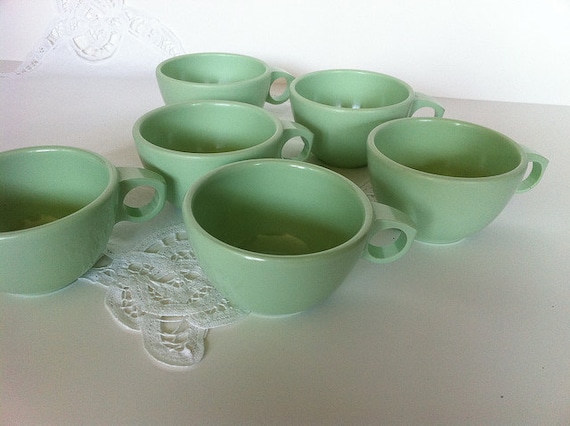 |
| Looks like Meladur because of size and handles, these at vintage19something. |
I found a Dallas Ware cup that looks identical to Meladur, but was short lived, I wonder if they (PMC that produced TexasWare) somehow obtained the molds along the way?
NON-WRIGHT TRAY MOLDS FOUND 2010?

Pink is classic Meladur, white is something new I found on the web and of course soon after lost the link. So I have to do some more investigating, you can be sure I'll be hot on the trail to see if it's Meladur!
OTHER CRAZY STUFF
WTH? A bag of Meladur? It's on this site, in another language! Maybe I should buy some and mold me some dishes!
This is called "Meladur" but obviously is NOT and featured here courtesy of this Museum which I can't read because it's in another language.
Before you go, check out this picture:
TIMELINE RECAP (More information is needed.)
| Timeline | |
|---|---|
| 1944 | Wright contracted to test durability of melamine by AM CY |
| 1945 | Blueprints made by Wright for "test line" while testing competition. |
| 1945-1946 | "Meladur" Test Set Undergoes Testing in NY Restaurants. |
| 1947-1949 | Wright is compiling results and asking to make a consumer & industrial line with AM CY. |
| 1949 | GATX starts producing Meladur |
| 1950-1953 | GATX and Wright have issues and contractual disputes. |
| 1954 | GATX Production Ends, by year end the molds are Sent to Lapcor (previously Lakeside Plastics) in Wisconsin to the Franklin Street plant. |
| 1954-? | Meanwhile, lookalikes are being produced in Canada by MAPLEX under "Rainboware" and in Australia by Duperite. NO indication of when or for how long this continued. |
| 1960??? | Lapcor ceases production. **ESTIMATE, need more evidence |
| 1980-1985 | Dallas Ware designs a cup very close to cup for Meladur. Meanwhile, Allied Chemical starts using the name "Meladur" but the dishes are nothing like the Meladur of yesteryear. |
| Late 1980s | Prolon produces a berry bowl a dead ringer for Meladur. #9610 |
| 2010 | Prolon's OP145 Tray is the Meladur large platter mold. According to Prolon owner, there is no #9610 berry bowls now being produced. |
| 2011 | I am still searching for Meladur! |
| STAY | TUNED! |
CONTACT ME If you have any other information regarding Meladur, or feedback on this page. Sometimes it takes me awhile to reply, but I'd love to talk plastic dishes with you!
To obtain value of your Meladur, get free general information HERE, or you can get it appraised by contacting me. For any other melmac that is not Russel Wright related, look for "Mr. Melmac's ad" on the front page of this site.
You May Also Like my page on Home Decorators:
COMING SOON:
COLOR CHART!
xxxxxxxxxxx
WORKS IN PROGRESS CODE 1234
You May Also Like my page on Home Decorators:
COMING SOON:
COLOR CHART!
xxxxxxxxxxx
Color Chart For Identification
Key:" X " Represents This Color Was Found **Indicates Actual Color Name
If you have any information to help me with the other color
names, I'd love to hear from you. | ||||
|---|---|---|---|---|
| COLOR | GATX SIGNED & UNSIGNED | LAPCOR | CANADA (FLAT BASES) | MISC |
| Dusty Rose | X | |||
| Dark Rose-hold | ||||
| Bubble Gum Pink | ||||
| Maroon | ||||
| Salmon Pink-Orange | ||||
| Pale Yellow | ||||
| Sunshine Yellow | ||||
| Mustard Yellow | ||||
| Dark Yellow | ||||
| Chartreuse Yellow | ||||
| Jade (Mint) Green | ||||
| Medium Green | ||||
| Forest Dark Green | ||||
| Powder Blue | ||||
| Muted Turquoise Blue | ||||
| Turq. Blue White Speckles | ||||
| Bright Teal Blue | ||||
| Dark Greyish Blue | ||||
| Pure White | ||||
| Ivory | ||||
| Tan | ||||
| Light Clay-Yellow Brown | ||||
| Sienna | ||||
| Sienna w/White Speckles | ||||
| RAINBOW SPECKLED | ||||
(b1) Industrial marketing: Volume 34, Issues 7-12, 1949
(b2) Consumer Reports of November 1954
(b3) Chicago Story / Commerce magazine - 1954 -
(b4)Railway age and railway review: 1953 -
(b5)1952 the journal of the American Hospital Association, Volume 26 page 136 SYFEIN
1956 the journal of the American Hospital Association, Volume 30 page 90 Debs Hospital Supplies, Inc 5990 N. Northwest Highway, Chicago ILL
(b8) hardware age 1969
b11
b11
College and university business
, Volume 6
(b12) Time Magazine 1949 p 79 Briton Hadden, Henry Robinson Luce
ad - American Home 1953 VOLUME 51










